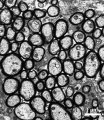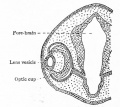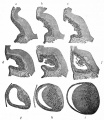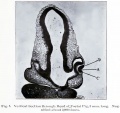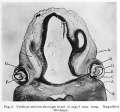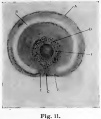Vision - Extraocular Muscle Development
Introduction
These notes introduce the development of the eye muscles. The adult eye has contributions from several different embryonic layers eventually forming neuronal, supportive connective tissue, optical structures, and muscular tissues. Additional pages are being developed to cover specific issues of this anatomical structure.
| Senses Links: Introduction | placode | Hearing and Balance hearing | balance | vision | smell | taste | touch | Stage 22 | Category:Sensory |
Some Recent Findings
Extraocular Muscles
Extraocular muscles are required to move the eye within the orbit. Their embryonic origin requires an interaction between the cranial mesoderm and the migrating neural crest cells.
The following is from a recent paper comparing human to zebrafish muscle development.[2]
| About the Muscles | Legend | |
|---|---|---|
|
|

|
Timeline
|
Embryonic Development
|
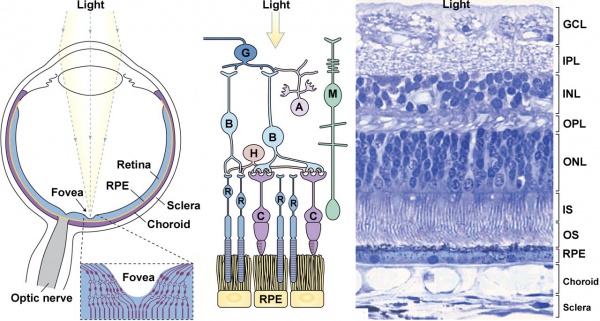
|
Carnegie Stages - Eye
The following data is from a study of human embryonic carnegie stages[3] and other sources.
- Stage 10 - optic primordia appear.
- Stage 11 - right and left optic primordia meet at the optic chiasma forming a U-shaped rim.
- Stage 12 - optic neural crest reaches its maximum extent and the optic vesicle becomes covered by a complete sheath,
- Stage 13 - By the end of the fourth week the optic vesicle lies close to the surface ectoderm. Optic evagination differentiation allows identification of optic part of retina, future pigmented layer of retina, and optic stalk. The surface ectoderm overlying the optic vesicle, in response to this contact, has thickened to form the lense placode.
- Stage 14 - (about 32 days) the lens placode is indented by the lens pit, cup-shaped and still communicates with the surface by a narrowing pore.
- Stage 15 - (about 33 days) the lens pit is closed. The lens vesicle and optic cup lie close to the surface ectoderm and appear to press against the surface.
- Stage 16 - (37 days) Growth of the lens body results in a D-shaped lens cavity. Perilental blood vessels (tunica vasculosa lentis) are visible. Prior to the development of the eyelids, one small sulcus or groove forms above the eye (eyelid groove) and another below it.
- Stages 17 - 19 - Retinal pigment is visible and the retinal fissure is largely closed. Eyelids grooves deepen, eyelid folds develop, first below, and then above, the eye.
- Stages 18 - Mesenchyme invades the region between the lens epithelium and the surface ectoderm.
- Stages 19 - 22 - the eyelid folds develop into the eyelids and cover more of the eye as the palpebral fissure takes shape. The upper and the lower eyelids meet at the outer canthus in Stage 19.
- Stage 20 - The lens cavity is lost and a lens suture begins to form. The inner canthus is established.
- Stage 23 - The retina comprises the pigmented layer, external limiting membrane, proliferative zone, external neuroblastic layer, transient fiber layer, internal neuroblastic layer, nerve fiber layer, and internal limiting membrane. Eyelids closure is complete (Note - shown as still open in the Kyoto embryo).
Ciliary Muscles
The lens focusses by refracting light as it passes through the biconvex lens, which can be altered in shape (accommodation) by surrounding ciliary muscles. These ciliary muscles are activated (contracted) by parasympathetic innervation from the ciliary ganglion itself innervated by the oculomotor nerve (Cranial Nerve III) (More? Cranial Nerves).
surface ectoderm -> lens placode -> lens pit -> lens vesicle -> lens fibres -> lens capsule and embryonic/fetal nucleus.
Neural Crest
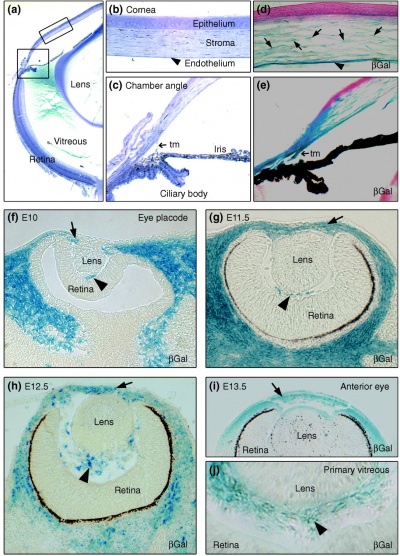
Mouse eye neural crest[4] |
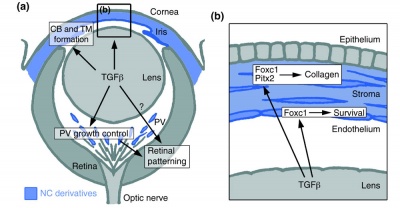
Mouse eye TGF-beta model[4] |
- Links: Image - Mouse eye neural crest | Image - Mouse eye TGF-beta model | Vision Development | Neural Crest Development | Head Development
Additional Images
Historic Images
References
Online Textbooks
- Developmental Biology (6th ed.) Gilbert, Scott F. Sunderland (MA): Sinauer Associates, Inc.; c2000. Evolution of the mammalian middle ear bones from the reptilian jaw | Chick embryo rhombomere neural crest cells | Some derivatives of the pharyngeal arches | Formation of the Neural Tube | Differentiation of the Neural Tube | Tissue Architecture of the Central Nervous System | Neuronal Types | Snapshot Summary: Central Nervous System and Epidermis
- Neuroscience Purves, Dale; Augustine, George J.; Fitzpatrick, David; Katz, Lawrence C.; LaMantia, Anthony-Samuel; McNamara, James O.; Williams, S. Mark. Sunderland (MA): Sinauer Associates, Inc. ; c2001 The Auditory System | The Inner Ear | The Middle Ear | The External Ear | Early Brain Development | Construction of Neural Circuits | Modification of Brain Circuits as a Result of Experience
- Molecular Biology of the Cell (4th Edn) Alberts, Bruce; Johnson, Alexander; Lewis, Julian; Raff, Martin; Roberts, Keith; Walter, Peter. New York: Garland Publishing; 2002. Neural Development | The three phases of neural development
- Clinical Methods 63. Cranial Nerves IX and X: The Glossopharyngeal and Vagus Nerves | The Tongue | 126. The Ear and Auditory System | An Overview of the Head and Neck - Ears and Hearing | Audiometry
- Health Services/Technology Assessment Text (HSTAT) Bethesda (MD): National Library of Medicine (US), 2003 Oct. Developmental Disorders Associated with Failure to Thrive
- Eurekah Bioscience Collection Cranial Neural Crest and Development of the Head Skeleton
Reviews
<pubmed>20855501</pubmed>| JCB
The International Journal of Developmental Biology Vol. 48 Nos. 8/9 (2004) Eye Development
Articles
<pubmed></pubmed>
Bookshelf Extraocular Muscle Development
Search Pubmed
Search Pubmed: Extraocular Muscle Development
Search Entrez: Extraocular Muscle Development
Terms
External Links
External Links Notice - The dynamic nature of the internet may mean that some of these listed links may no longer function. If the link no longer works search the web with the link text or name. Links to any external commercial sites are provided for information purposes only and should never be considered an endorsement. UNSW Embryology is provided as an educational resource with no clinical information or commercial affiliation.
Glossary Links
- Glossary: A | B | C | D | E | F | G | H | I | J | K | L | M | N | O | P | Q | R | S | T | U | V | W | X | Y | Z | Numbers | Symbols | Term Link
Cite this page: Hill, M.A. (2024, May 4) Embryology Vision - Extraocular Muscle Development. Retrieved from https://embryology.med.unsw.edu.au/embryology/index.php/Vision_-_Extraocular_Muscle_Development
- © Dr Mark Hill 2024, UNSW Embryology ISBN: 978 0 7334 2609 4 - UNSW CRICOS Provider Code No. 00098G









